2002 BMW M6 CONVERTIBLE engine
[x] Cancel search: enginePage 160 of 186
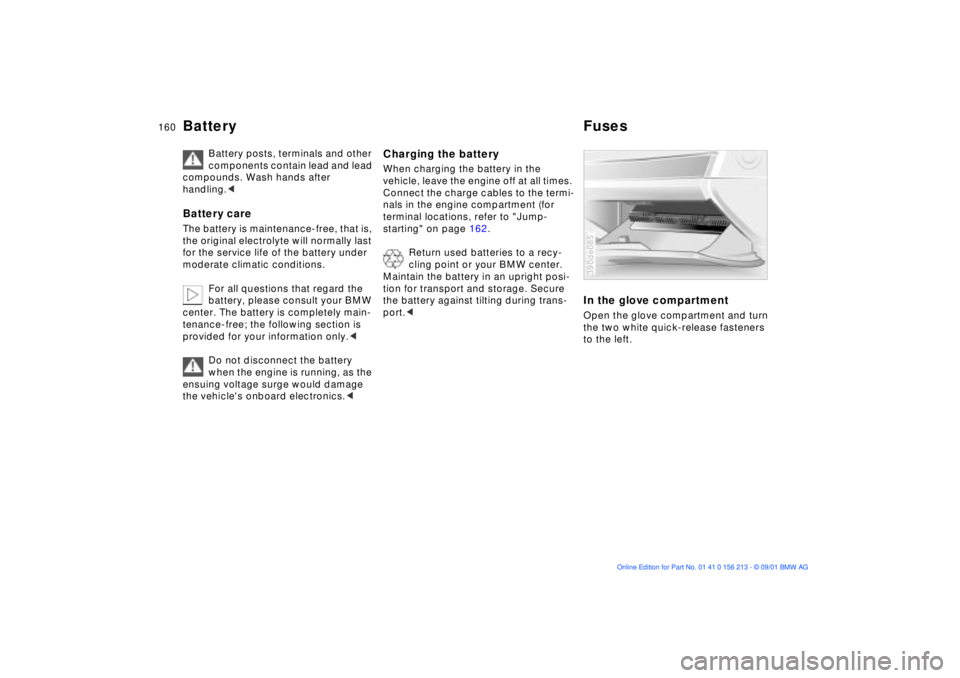
160n
Battery Fuses
Battery posts, terminals and other
components contain lead and lead
compounds. Wash hands after
handling.<
Battery careThe battery is maintenance-free, that is,
the original electrolyte will normally last
for the service life of the battery under
moderate climatic conditions.
For all questions that regard the
battery, please consult your BMW
center. The battery is completely main-
tenance-free; the following section is
provided for your information only.<
Do not disconnect the battery
when the engine is running, as the
ensuing voltage surge would damage
the vehicle's onboard electronics.<
Charging the batteryWhen charging the battery in the
vehicle, leave the engine off at all times.
Connect the charge cables to the termi-
nals in the engine compartment (for
terminal locations, refer to "Jump-
starting" on page 162.
Return used batteries to a recy-
cling point or your BMW center.
Maintain the battery in an upright posi-
tion for transport and storage. Secure
the battery against tilting during trans-
port.<
In the glove compartmentOpen the glove compartment and turn
the two white quick-release fasteners
to the left.390de085
Page 162 of 186
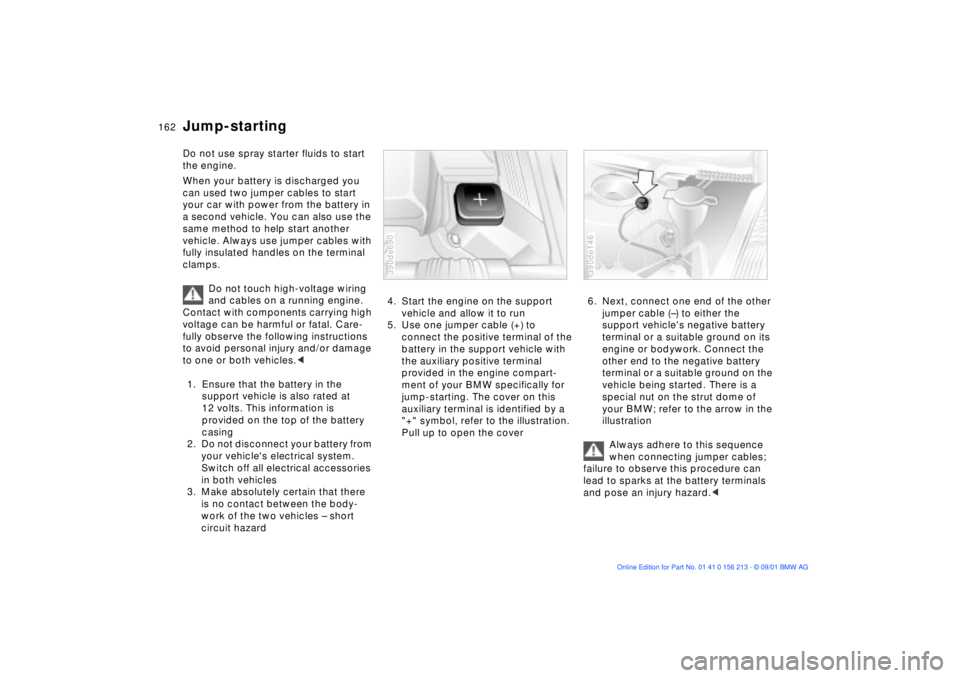
162n
Do not use spray starter fluids to start
the engine.
When your battery is discharged you
can used two jumper cables to start
your car with power from the battery in
a second vehicle. You can also use the
same method to help start another
vehicle. Always use jumper cables with
fully insulated handles on the terminal
clamps.
Do not touch high-voltage wiring
and cables on a running engine.
Contact with components carrying high
voltage can be harmful or fatal. Care-
fully observe the following instructions
to avoid personal injury and/or damage
to one or both vehicles.<
1. Ensure that the battery in the
support vehicle is also rated at
12 volts. This information is
provided on the top of the battery
casing
2. Do not disconnect your battery from
your vehicle's electrical system.
Switch off all electrical accessories
in both vehicles
3. Make absolutely certain that there
is no contact between the body-
work of the two vehicles Ð short
circuit hazard
4. Start the engine on the support
vehicle and allow it to run
5. Use one jumper cable (+) to
connect the positive terminal of the
battery in the support vehicle with
the auxiliary positive terminal
provided in the engine compart-
ment of your BMW specifically for
jump-starting. The cover on this
auxiliary terminal is identified by a
"+" symbol, refer to the illustration.
Pull up to open the cover390de690
6. Next, connect one end of the other
jumper cable (Ð) to either the
support vehicle's negative battery
terminal or a suitable ground on its
engine or bodywork. Connect the
other end to the negative battery
terminal or a suitable ground on the
vehicle being started. There is a
special nut on the strut dome of
your BMW; refer to the arrow in the
illustration
Always adhere to this sequence
when connecting jumper cables;
failure to observe this procedure can
lead to sparks at the battery terminals
and pose an injury hazard.< 390de146
Jump-starting
Page 163 of 186
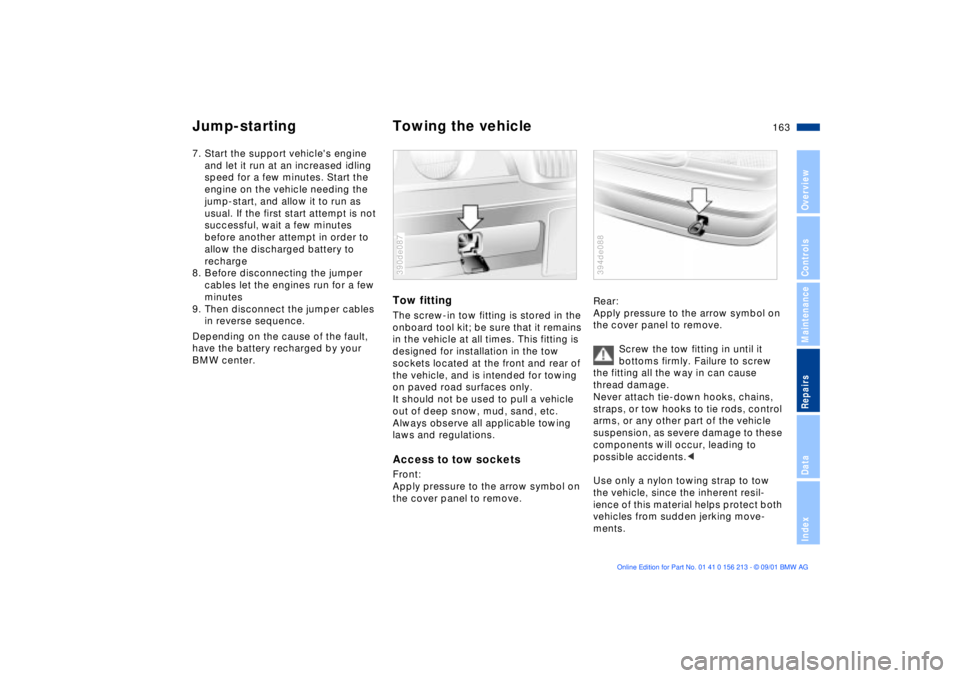
163n
OverviewControlsMaintenanceRepairsDataIndex
Jump-starting Towing the vehicle7. Start the support vehicle's engine
and let it run at an increased idling
speed for a few minutes. Start the
engine on the vehicle needing the
jump-start, and allow it to run as
usual. If the first start attempt is not
successful, wait a few minutes
before another attempt in order to
allow the discharged battery to
recharge
8. Before disconnecting the jumper
cables let the engines run for a few
minutes
9. Then disconnect the jumper cables
in reverse sequence.
Depending on the cause of the fault,
have the battery recharged by your
BMW center.
Tow fittingThe screw-in tow fitting is stored in the
onboard tool kit; be sure that it remains
in the vehicle at all times. This fitting is
designed for installation in the tow
sockets located at the front and rear of
the vehicle, and is intended for towing
on paved road surfaces only.
It should not be used to pull a vehicle
out of deep snow, mud, sand, etc.
Always observe all applicable towing
laws and regulations.Access to tow socketsFront:
Apply pressure to the arrow symbol on
the cover panel to remove.390de087
Rear:
Apply pressure to the arrow symbol on
the cover panel to remove.
Screw the tow fitting in until it
bottoms firmly. Failure to screw
the fitting all the way in can cause
thread damage.
Never attach tie-down hooks, chains,
straps, or tow hooks to tie rods, control
arms, or any other part of the vehicle
suspension, as severe damage to these
components will occur, leading to
possible accidents.<
Use only a nylon towing strap to tow
the vehicle, since the inherent resil-
ience of this material helps protect both
vehicles from sudden jerking move-
ments.394de088
Page 164 of 186
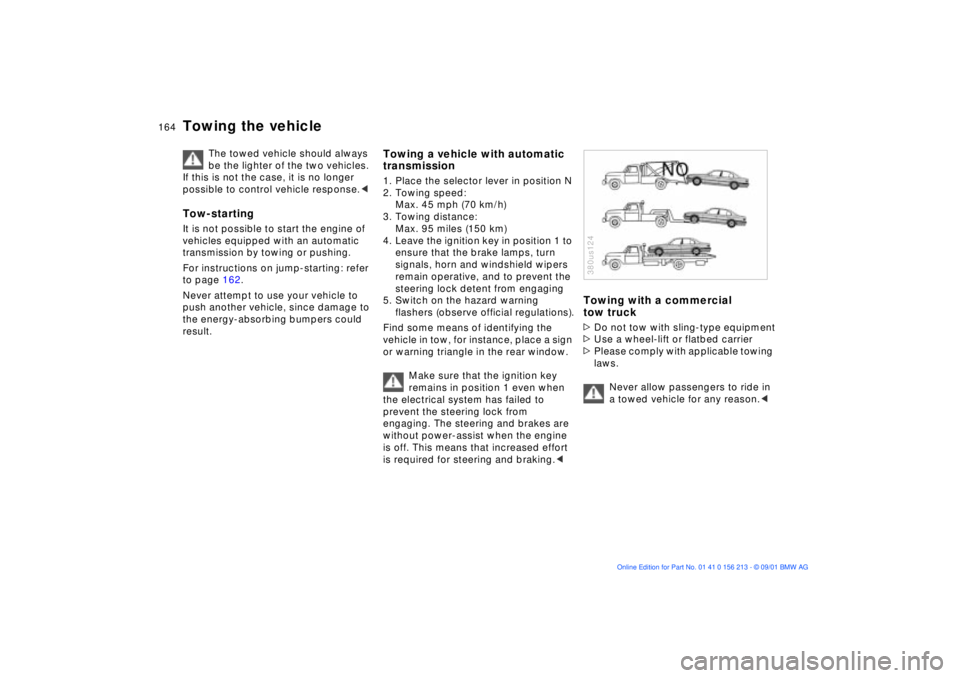
164n
Towing the vehicle
The towed vehicle should always
be the lighter of the two vehicles.
If this is not the case, it is no longer
possible to control vehicle response.<
Tow-startingIt is not possible to start the engine of
vehicles equipped with an automatic
transmission by towing or pushing.
For instructions on jump-starting: refer
to page 162.
Never attempt to use your vehicle to
push another vehicle, since damage to
the energy-absorbing bumpers could
result.
Towing a vehicle with automatic
transmission1. Place the selector lever in position N
2. Towing speed:
Max. 45 mph (70 km/h)
3. Towing distance:
Max. 95 miles (150 km)
4. Leave the ignition key in position 1 to
ensure that the brake lamps, turn
signals, horn and windshield wipers
remain operative, and to prevent the
steering lock detent from engaging
5. Switch on the hazard warning
flashers (observe official regulations).
Find some means of identifying the
vehicle in tow, for instance, place a sign
or warning triangle in the rear window.
Make sure that the ignition key
remains in position 1 even when
the electrical system has failed to
prevent the steering lock from
engaging. The steering and brakes are
without power-assist when the engine
is off. This means that increased effort
is required for steering and braking.<
Towing with a commercial
tow truck>Do not tow with sling-type equipment
>Use a wheel-lift or flatbed carrier
>Please comply with applicable towing
laws.
Never allow passengers to ride in
a towed vehicle for any reason.< 380us124
Page 168 of 186

168n
BMW 525i/sport wagon BMW 530i BMW 540i/sport wagon
Displacement
Number of cylinderscu in (cm
3) 152.2 (2,494)
6181.8 (2,979)
6268.4 (4,398)
8
Maximum output
at engine speedhp
rpm184
6,000225
5,900290
5,400
Maximum torque
at engine speedIb ft (Nm)
rpm175 (236)
3,500214 (289)
3,500324 (440)
3,600
Compression ratioe10.5 10.2 10.0
Stroke
Borein (mm)
in (mm)2.95 (75.0)
3.31 (84.0)3.53 (89.6)
3.31 (84.0)3.26 (82.7)
3.62 (92.0)
Fuel-injection system
Digital electronic engine-management system
Engine specifications
Page 173 of 186

173n
OverviewControlsMaintenanceRepairsDataIndex
Capacities
Notes
Fuel tank
Reservegal. (liters)
gal. (liters)approx. 18.5 (approx. 70)
approx. 2.0 (approx. 8) Ð BMW 525i, 530i
approx. 2.5 (approx. 10) Ð BMW 540iFuel specification: page 25
Windshield washer system
with headlamp washer system
Intensive cleaning systemquarts (liters)
quarts (liters)
quarts (liters)approx. 3.7 (approx. 3.5)
approx. 6.3 (approx 6.0)
approx. 1.1 (approx 1.0)For details: page 139
Cooling system including
heater circuitquarts (liters) 11.1 (10.5) Ð BMW 525i, 530i
12.7 (12.0) Ð BMW 540iFor details: page 142
Engine oil and filter change quarts (liters) 6.9 (6.5) Ð BMW 525i, 530i
7.9 (7.5) Ð BMW 540i"BMW High Performance
Synthetic Oil."
For details: page 141
Manual transmission, automatic
transmission and differentialÐ Ð Lifetime fluid, no fluid
change required
Page 176 of 186
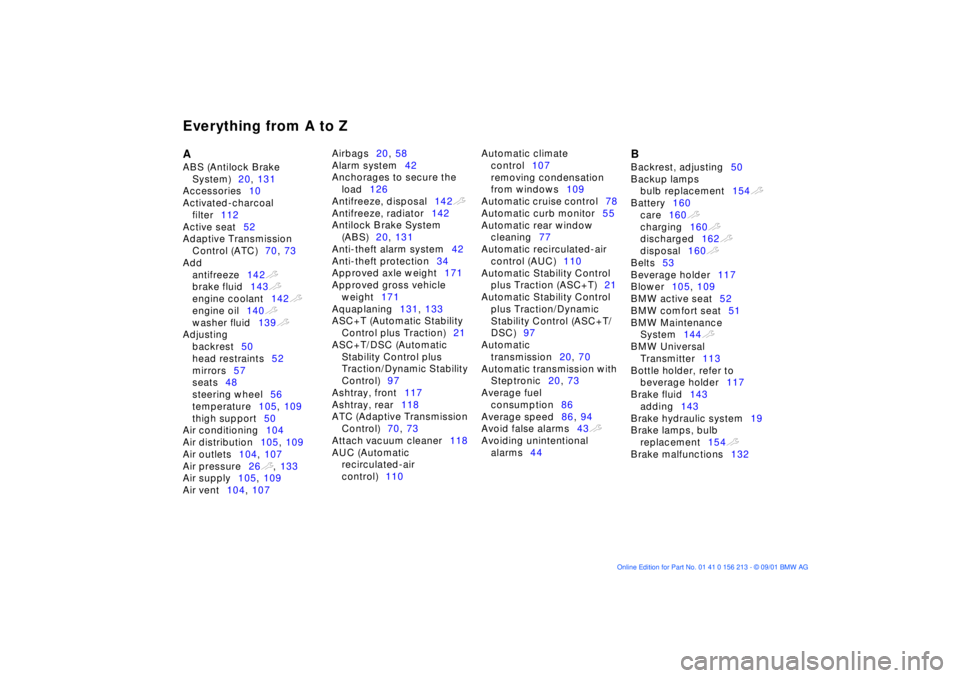
Everything from A to ZA
ABS (Antilock Brake
System)20, 131
Accessories10
Activated-charcoal
filter112
Active seat52
Adaptive Transmission
Control (ATC)70, 73
Add
antifreeze142t
brake fluid143t
engine coolant142t
engine oil140t
washer fluid139t
Adjusting
backrest50
head restraints52
mirrors57
seats48
steering wheel56
temperature105, 109
thigh support50
Air conditioning104
Air distribution105, 109
Air outlets104, 107
Air pressure26t, 133
Air supply105, 109
Air vent104, 107 Airbags20, 58
Alarm system42
Anchorages to secure the
load126
Antifreeze, disposal142t
Antifreeze, radiator142
Antilock Brake System
(ABS)20, 131
Anti-theft alarm system42
Anti-theft protection34
Approved axle weight171
Approved gross vehicle
weight171
Aquaplaning131, 133
ASC+T (Automatic Stability
Control plus Traction)21
ASC+T/DSC (Automatic
Stability Control plus
Traction/Dynamic Stability
Control)97
Ashtray, front117
Ashtray, rear118
ATC (Adaptive Transmission
Control)70, 73
Attach vacuum cleaner118
AUC (Automatic
recirculated-air
control)110 Automatic climate
control107
removing condensation
from windows109
Automatic cruise control78
Automatic curb monitor55
Automatic rear window
cleaning77
Automatic recirculated-air
control (AUC)110
Automatic Stability Control
plus Traction (ASC+T)21
Automatic Stability Control
plus Traction/Dynamic
Stability Control (ASC+T/
DSC)97
Automatic
transmission20, 70
Automatic transmission with
Steptronic20, 73
Average fuel
consumption86
Average speed86, 94
Avoid false alarms43t
Avoiding unintentional
alarms44
B
Backrest, adjusting50
Backup lamps
bulb replacement154t
Battery160
care160t
charging160t
discharged162t
disposal160t
Belts53
Beverage holder117
Blower105, 109
BMW active seat52
BMW comfort seat51
BMW Maintenance
System144t
BMW Universal
Transmitter113
Bottle holder, refer to
beverage holder117
Brake fluid143
adding143
Brake hydraulic system19
Brake lamps, bulb
replacement154t
Brake malfunctions132
Page 177 of 186

Everything from A to Z
177n
OverviewControlsMaintenanceRepairsDataIndex
Brake system132
brake fluid level132
brake pads20, 132
disc brakes132
malfunctions132
Break-in procedures130
Bulbs and lamps151t C
California Proposition
65 Warning145
Capacities173
Car care, refer to the "Caring
for your vehicle" manual
Car wash systems, refer to
the "Caring for your
vehicle" manual
Care of paintwork, refer to
the "Caring for your
vehicle" manual
Care of upholstery materials,
refer to the "Caring for your
vehicle" manual
Cargo area
lamps103
opening from the
inside40
Cargo loading126
Cellular phone117 Center (high-mount) brake
lamp155
Central locking
system32, 37
Changing a wheel/
tire157t
Charge indicator lamp19
CHECK button83
Check Control83t
Check engine oil
level140t
Child seat safety62
Child seats61
Child-restraint systems61
Child-safety locks64
Cigarette lighter118
Clean rear window77
Cleaning windshield77
Climate control, refer to
Automatic climate
control107
Clock88
for additional information
refer to the "Owner's
Manual for Onboard
Computer"
Cockpit14
Code, refer to immoblizer
function94
Cold start67
Combination switch76 Comfort seat51
Compartments116
Computer86
for additional information
refer to the "Owner's
Manual for Onboard
Computer"
remote control95
Computer in the MID91
Configuring personal
adjustments, Vehicle and
Key Memory64
Consumption display81
Consumption, fuel86, 93
Convenience operation of
windows and sliding/tilt
sunroof33
Convenience starting
feature67
Coolant142
Coolant temperature
gauge82
Copyright4
Cover, sun blinds112
Cruising range86, 93
Cup holder117
Cup holder, refer to
beverage holder117
Curb monitor55
D
Data link connector for
Onboard Diagnostics146
Date
calling up88
changing88
Daytime driving lamps101
DBC (Dynamic Brake
Control)20
Deactivating95
alarm system tilt
sensor43
interior motion sensor43
Deep water131
Defrost windows106, 109
Defroster mode106, 109
Digital clock in the MID88
Dimensions169
Dipstick, engine oil140t
Displacement168
Display lighting102
Displays16, 17
Disposal
antifreeze with corrosion
inhibitor142t
used batteries160t
used oils141t